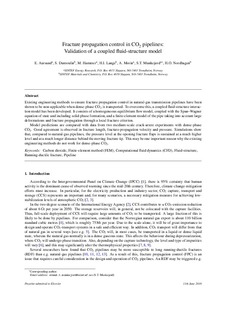| dc.contributor.author | Aursand, Eskil | |
| dc.contributor.author | Dumoulin, Stephane | |
| dc.contributor.author | Hammer, Morten | |
| dc.contributor.author | Lange, Hans Iver | |
| dc.contributor.author | Morin, Alexandre | |
| dc.contributor.author | Munkejord, Svend Tollak | |
| dc.contributor.author | Nordhagen, Håkon Ottar | |
| dc.date.accessioned | 2018-05-30T08:14:00Z | |
| dc.date.available | 2018-05-30T08:14:00Z | |
| dc.date.created | 2016-05-20T15:51:07Z | |
| dc.date.issued | 2016 | |
| dc.identifier.citation | Engineering structures. 2016, 123 192-212. | nb_NO |
| dc.identifier.issn | 0141-0296 | |
| dc.identifier.uri | http://hdl.handle.net/11250/2499723 | |
| dc.description.abstract | Existing engineering methods to ensure fracture propagation control in natural-gas transmission pipelines have been shown to be non-applicable when dense-phase CO2 is transported. To overcome this, a coupled fluid-structure interaction model has been developed. It consists of a homegeneous equlibrium flow model, coupled with the Span–Wagner equation of state and including solid-phase formation, and a finite-element model of the pipe taking into account large deformations and fracture propagation through a local fracture criterion. Model predictions are compared with data from two medium-scale crack-arrest experiments with dense-phase CO2. Good agreement is observed in fracture length, fracture propagation velocity and pressure. Simulations show that, compared to natural-gas pipelines, the pressure level at the opening fracture flaps is sustained at a much higher level and at a much longer distance behind the moving fracture tip. This may be one important reason why the existing engineering methods do not work for dense-phase CO2. | nb_NO |
| dc.language.iso | eng | nb_NO |
| dc.relation.uri | http://www.pvv.org/~stm/research/coupled-co2_preprint.pdf | |
| dc.rights | Attribution-NonCommercial-NoDerivatives 4.0 Internasjonal | * |
| dc.rights.uri | http://creativecommons.org/licenses/by-nc-nd/4.0/deed.no | * |
| dc.title | Fracture propagation control in CO2 pipelines: Validation of a coupled fluid-structure model | nb_NO |
| dc.type | Journal article | nb_NO |
| dc.type | Peer reviewed | nb_NO |
| dc.description.version | acceptedVersion | nb_NO |
| dc.rights.holder | Authors have copyright to accepted version | nb_NO |
| dc.source.pagenumber | 192-212 | nb_NO |
| dc.source.volume | 123 | nb_NO |
| dc.source.journal | Engineering structures | nb_NO |
| dc.identifier.doi | 10.1016/j.engstruct.2016.05.012 | |
| dc.identifier.cristin | 1356621 | |
| dc.relation.project | Norges forskningsråd: 193816 | nb_NO |
| cristin.unitcode | 7548,60,0,0 | |
| cristin.unitcode | 7401,80,6,6 | |
| cristin.unitcode | 7401,80,6,5 | |
| cristin.unitname | Gassteknologi | |
| cristin.unitname | Material- og konstruksjonsmekanikk | |
| cristin.unitname | Materialers integritet og sveising | |
| cristin.ispublished | true | |
| cristin.fulltext | postprint | |
| cristin.qualitycode | 2 | |

